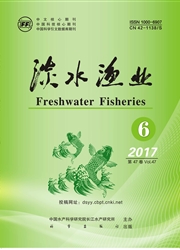

 中文摘要:
中文摘要:
采用放射免疫分析测定法(RIA)对人工繁殖的中华鲟(Acipenser sinensis)早期发育阶段中17β-雌二醇(17β-estradiol,E2)和睾酮(testosterone,T)的整体水平进行了测定。实验共测定了4批次(分别来自4尾雌鲟)受精卵及仔鱼的E2和T水平,结果表明:中华鲟胚胎发育期间E2水平在小范围内波动,T水平除胚胎发育早期出现上升外总体呈下降趋势;仔鱼出膜后E2水平开始逐渐上升,T水平是先降低后又逐渐升高。其中第1批次的测定结果(单位为Pg/gtissue)为:胚胎发育期间E2水平在1.37~7.38之间波动,仔鱼出膜后3d为5.21,出膜后9d为37.26;胚胎发育期间T水平最低为293.58,最高为1420.41,仔鱼出膜后4d为117.96,出膜后7d为27.25,出膜后9d为148.48。对于仔鱼出膜后体内高水平的E2和T的来源,推测其可能与仔鱼自身合成性类固醇激素有关。另外,本实验中还发现,质量较差的卵子T水平明显低于质量较好者。
 英文摘要:
英文摘要:
The Chinese sturgeon, Acipenser sinensis Gray, is a large anadromous fish. The fish is listed in the National Glass Ⅰ Protected Animals, and the artificial spawning has been performed. In the experiment, the levels of 17β-estradiol ( E2 ) and testosterone (T) during the early development of Chinese sturgeon were measured by radioimmunoassay (RIA). The levels of E2 and T of four batches of eggs and larvae were measured. The results showed that the level of E2 during embryonic development changed a little, while the level of T descended all through except for the early embryogenesis stage. After the larvae were hatched out, the level of E2 increased, but there was a decline of T level before it increased. The levels of E2 and T for one batch of eggs and larvae were as follows. The unit of levels of E2 and T were expressed by pg/g tissue. During the embryonic development, the level of E2 fluctuated between 1.37 -7.38. The level of E2 was 5.21 at three days after larvae hatching, and 37.26 at nine days after larvae hatching. The lowest and highest levels of T were 293.58 and 1420.41 respectively during the embryonic development. When the larvae were out, the level of T was 117.96 at four days after hatching, 27.25 at seven days after hatching, and 148.48 at nine days after hatching. The high levels of E2 and T in the larvae may be related with the sex steroids produced by the larvae. In addition, the result showed that the level of T in high-quality eggs was higher than that in the low-quality eggs.
 同期刊论文项目
同期刊论文项目
 同项目期刊论文
同项目期刊论文
 期刊信息
期刊信息
